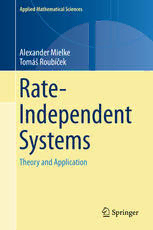Table Of ContentApplied Mathematical Sciences
Alexander Mielke
Tomáš Roubíček
Rate-
Independent
Systems
Theory and Application
Applied Mathematical Sciences
Volume 193
FoundingEditors
FritzJohn,JosephP.LaSalleandLawrenceSirovich
Editors
S.S.Antman
[email protected]
LeslieGreengard
[email protected]
P.J.Holmes
[email protected]
Advisors
J.Bell
R.Kohn
J.Keller
R.Pego
L.Ryzhik
A.Singer
A.Stevens
A.Stuart
S.Wright
Moreinformationaboutthisseriesathttp://www.springer.com/series/34
Alexander Mielke • Tomáš Roubícˇek
Rate-Independent Systems
Theory and Application
123
AlexanderMielke TomášRoubícˇek
Weierstraß-Institutfür MathematicalInstitute
AngewandteAnalysisundStochastik CharlesUniversity
Berlin,Germany Prague,CzechRepublic
InstitutfürMathematik InstituteofThermomechanics
Humboldt-UniversitätzuBerlin CzechAcademyofSciences
Berlin,Germany Prague,CzechRepublic
InstituteofInformation
TheoryandAutomation
CzechAcademyofSciences
Prague,CzechRepublic
ISSN0066-5452 ISSN2196-968X (electronic)
AppliedMathematicalSciences
ISBN978-1-4939-2705-0 ISBN978-1-4939-2706-7 (eBook)
DOI10.1007/978-1-4939-2706-7
LibraryofCongressControlNumber:2015938159
MathematicsSubjectClassification(2010):35K90,35K86,35Q74,47J35,49S05,65J08,65Z05,74A30,
74A15,74C05,74C15,74F05,74M15,74N30,74R05
SpringerNewYorkHeidelbergDordrechtLondon
©SpringerScience+BusinessMediaNewYork2015
Thisworkissubjecttocopyright.AllrightsarereservedbythePublisher,whetherthewholeorpartof
thematerialisconcerned,specificallytherightsoftranslation,reprinting,reuseofillustrations,recitation,
broadcasting,reproductiononmicrofilmsorinanyotherphysicalway,andtransmissionorinformation
storageandretrieval,electronicadaptation,computersoftware,orbysimilarordissimilarmethodology
nowknownorhereafterdeveloped.
Theuseofgeneraldescriptivenames,registerednames,trademarks,servicemarks,etc.inthispublication
doesnotimply,evenintheabsenceofaspecificstatement,thatsuchnamesareexemptfromtherelevant
protectivelawsandregulationsandthereforefreeforgeneraluse.
Thepublisher,theauthorsandtheeditorsaresafetoassumethattheadviceandinformationinthisbook
arebelievedtobetrueandaccurateatthedateofpublication.Neitherthepublishernortheauthorsor
theeditorsgiveawarranty,expressorimplied,withrespecttothematerialcontainedhereinorforany
errorsoromissionsthatmayhavebeenmade.
Printedonacid-freepaper
SpringerScience+BusinessMediaLLCNewYorkispartofSpringerScience+BusinessMedia(www.
springer.com)
Tothememoryofmyparents,
ElliandEduardMielke.
Tothememoryofmyfather,
HanušRoubícˇek,
andallthosewholosttheirlivestogivehim,
likeonlyafewothers,achancetosurvivethe
Holocaust,specificallytothememoryof
5862childrenagedundertenwhomtheir
parentssacrificedonSeptember4,1942,in
Litzmannstadt/Łódz´ anddozensof
Czechoslovakphysiciansandnurseswho
diedinMayandJune1945at
Theresienstadt/Terezínwhileserving
voluntarilyduringatyphusepidemicthere.
Preface
Ourworkonrate-independentsystemswasstimulatedbyoursearchforevolution-
arymaterialmodelsforshape-memoryalloysthatareflexibleenoughtoencompass
nonlinear and nonconvex phenomena. There are two difficulties, namely (i) mod-
eling the nonlinear material behavior and (ii) modeling the dissipative processes.
Undertheguidanceofclassicalthermodynamics,mostmaterialmodelsassumethat
the forces induced by dissipative effects are linear in the rates of the associated
variables, such as in viscoelastic friction. However, there are certain effects, such
asdryfriction,plasticity,andfracture,forwhichtheforcedependsonthedirection
oftheratebutnotonitsmagnitude.Suchprocessesarecalledrate-independentand
includetheclassofhysteresisoperators.Thelattermayrelatethematerialresponse
(suchasstressormagnetization)tothechangesofthematerialstate(suchasstrain
ormagneticfield,respectively).Ingeneral,theremaybememoryeffects,andrate-
independencemeansthatanymonotonetemporalrescalingoftheinputleadstothe
samecorrespondinglyrescaledoutput.Afirstmathematicalformulationofsuchan
invarianceofthematerialresponseundertemporalrescalingsiscontainedin[601,
§99]inthecontextofhypoelasticmaterials.
Of course, rate-independence is an idealization that is admissible only if the
relevant processes of a system take place on a much slower time scale than the
internal relaxation processes. In this book, we restrict our attention primarily to
fully rate-independent systems, which can be justified in two ways. First, many
mechanical processes can be well described by fully rate-independent models.
Second, the restriction to such models allows for new mathematical tools for
facilitatingrigorousmathematicalandnumericalanalysisthatarenotavailablefor
modelswithviscousdissipation.Forinstance,sofar,theonlyexistenceresultforthe
time-continuous evolutionary system for finite-strain elastoplasticity was obtained
intherate-independentcase;seeSection4.2and[374].
The description and discussion of rate-independent mechanical behavior has a
relatively long history. Already in the eighteenth century, C.-A. Coulomb treated,
besideshisfamouscontributiontoelectricity,dryfrictionin[138],statinghisLaw
of Friction: “Kinetic friction is independent of the sliding velocity”. In the early
twentiethcentury,thetheoryofelastoplasticitybecameamajortopicinmechanics
vii
viii Preface
(e.g.,[246,265,490,617,618]),whereagainrate-independenteffectsfortheflow
rule occur. However, the mathematical treatment of the associated evolutionary
systems was not attacked until the 1970s, when J.-J. Moreau introduced methods
fromconvexanalysistostudyrate-independentmodels,whichhecalledsweeping
processes; see [434, 435]. These works and some parallel works on monotone
operatortheorytriggeredthedevelopmentofawholemathematicalfieldonanalysis
andnumericsofelastoplasticity(atsmallstrains);see[291,578,589]andthelargely
unnoticedparallelwork[235,237,238,240,276]atZentralinstitutfürMathematik
und Mechanik of the Akademie der Wissenschaften der DDR, which can be seen
asapredecessoroftheWeierstraß-InstitutfürAngewandteAnalysisundStochastik
(WIAS). See also [8,257] for more information on the historical and more recent
developmentofsmall-strainelastoplasticity.
Roughlyatthesametime,themodelingofmaterialswasputonamoregeneral
level through the introduction of the notion of generalized standard materials by
B.Halphen and Q.C.Nguyen [254], cf. also [218, 629], using convex dissipation
potentialsforgeneralinternalvariables,theconcepthavingbeenintroducedearlier
by P.W.Bridgman [97]. Thus, besides plasticity, one is also able to treat phase
transformations, magnetization, piezoelectric effects, damage, and fracture; see
[204,383]and[101,207]forrelevantmodelsforshape-memorymaterials.
The name hysteresis was probably introduced by Sir J.A.Ewing in his report
“Onhysteresisintherelationofstraintostress”(BritishAssociationReports,502,
1889).WhilethesystematicstudyofhysteresisgoesbacktoPrandtl,Preisach,and
Ishlinskii,see[279,491,492],themathematicaltheoryofhysteresisoperatorswas
begunbyM.A.Krasnosel’ski˘ıandA.V.Pokrovski˘ı[316]withthepropertyofrate-
independenceplayingamajorroleinthedefinition.Wereferto[101,317,320,608]
forrecentexpositions.Inthepresentwork,wedonotrelyonthenotionofmemory
or hysteresis operators, since we are always including the internal variables (also
calledmemoryvariables)inthestateofthesystemtobedescribed,thusobtaining
evolutionarysystems;seethediscussioninSection1.2.
Except for Chapter 5, this book focuses on quasistatic evolutionary systems
thatarerate-independent.Mostly,weconfineourselvestorate-independentsystems
.Q;E;D/,whereQisthestatespace,E isanenergy-storagefunctional,andD isa
dissipationdistance;wewillcallsuchsystemsenergeticrate-independentsystems
(ERIS) because both E and D are physically in concrete applications indeed
energies.Thenatural(and,consideringtheamenabilityfortheoreticalanalysis,the
only) solutions generalizing other standard concepts for this general situation are
the so-called energetic solutions q W Œ0;T(cid:2) ! Q as introduced in [426]. They are
characterized by the static stability condition (S) and the total energy balance (E)
forallt2Œ0;T(cid:2):
(S) E.t;q.t//(cid:2)E.t;qQ/CD.q.t/;qQ/ forall qQ2Q;
Z
t
(E) E.t;q.t//CDissD.q;Œ0;t(cid:2)/DE.0;q.0//C @sE.s;q.s//ds;
0
Preface ix
withDissD.q;Œ0;t(cid:2)/thetotaldissipation((cid:3)variation)inducedbyD oftheprocess
qonthetimeintervalŒ0;t(cid:2).Thesesolutionsarealsocalledirreversiblequasistatic
evolutionsinthefracturemodelsstudiedin[149,152].Infact,thegeneralexistence
resultpresentedinthisworkreliesinpartonthemethodsdevelopedintheseworks.
The advantage of this definition is that it does not involve derivatives of E, D,
andq,andhenceisveryflexiblefortreatingnonsmoothandnonconvexsituations,
evenapplicationswithoutanunderlyinglinearstructure.Moreover,approximation
results in the sense of (cid:3)-convergence or numerical finite- or boundary-element
methods can be developed quite easily. On the other hand, energetic solutions are
intimately based on global energy minimization, which might be not an entirely
relevantconceptinsomeapplications,especiallyifthereisnounderlyingconvexity
structure. Therefore, another focus is on “more local” concepts of solutions. A
largeportionofthebookdealswithamorespecialsituationwherebysomenatural
underlyinglinearstructureisatone’sdisposal,andwecan(atleastformally)specify
.
thetimederivativeqandthedrivingforce(cid:4)@ E,andthedissipationdistanceD can
. q
beinducedbyadissipationmetricR.q;q/.InsteadofERIS.Q;E;D/,wewillthen
speakjustaboutarate-independentsystem(RIS) determinedbythetriple.Q;E;R/
and governed (again at least formally) by an abstract doubly nonlinear evolution
inclusion
.
@.R.q;q/C@ E.t;q/30:
q q
Physically, in concrete applications, R is a power, whereas as already stated, E
andD representenergies.Therate-independenceisreflectedbythepropertyofthe
.
dissipationmetricRbeing1-homogeneousintermsoftherateq,orinotherwords,
the dissipation potential R.qI(cid:5)/ is positively homogeneous of degree 1, so that
particularsituationsmaybeveryirregular,exhibiting,forexample,jumpsevenifthe
externalloadingevolvessmoothly.Inadditiontotheenergeticsolutions,thereisa
menagerieofothersolutionconceptsallofwhichfallessentiallyintoaconventional
weak-solutionconceptifqisabsolutelycontinuousintime,butwhichmayexhibit
verydifferentfeatures,inparticularintheaforementionedirregularsituations.
The book is organized as follows. In Chapter 1, we introduce the subject on
a rather intuitive and elementary level. The general existence theory for ERIS,
which is based on incremental minimization problems, is presented in Chapter 2.
Moreover, a general theory of (cid:3)-convergence is developed there. While that
chapter does not rely on any underlying linear structure, Chapter 3 addresses RIS
.Q;E;R/ and the situations in which Q is a weakly closed subset of a Banach
space Q,which allows for more specific considerations exploiting the concepts of
differentials, convexity, and duality. To some extent, the origin and the prominent
applicationoftheabovetheoryisthecontinuummechanicsofdeformablesolidsor
of undeformable ferroic materials. Relying on the concept of internal variables, in
Chapter4wediscussspecificinelasticprocessesinthebulkasplasticity,damage,
and phase transformations, as well as some inelastic processes on the boundary,
both at large and at small strains. Selected applications are discussed in all detail,
whereas a greater number of applications are treated in only a summary fashion.

